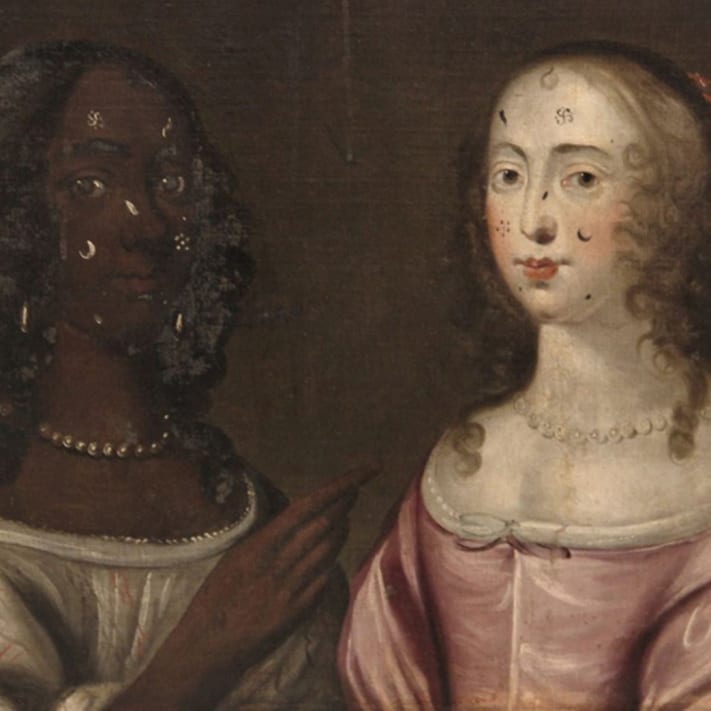17th-century painting showing a Black woman with her White companion has been placed under a temporary export bar to reduce the risk of the artwork leaving the United Kingdom.
Vocabulary
allegorical | /ˌaləˈɡôrək(ə)l/ adj. in or relating to a story, play, picture, or other work in which the characters and events represent moral, religious, or political qualities or ideas: Ex: … the composition is allegorical |
anonymous | /əˈnänəməs/ adj. Not identified by name; of unknown name: Ex: The anonymous painting is… |
impartial | /imˈpärSH(ə)l/ adj. Treating all rivals or disputants equally; fair and just: Ex: …an independent body that offers impartial advice. |
rarity | /ˈrerədē/ n. something rare, unusual, or uncommon: Ex: This anonymous painting is a great rarity in British art. |
stern | /stərn/ adj. (of a person or their manner) serious and unrelenting, especially in the assertion of authority and exercise of discipline: Ex: …sternly moralizing picture |
Comprehension Questions
What is the anonymous painting about?
What makes the painting unique?
What does the style of the artwork correlate with?
What has this painting taught about England in the 17th century?
What could be explored through the painting?
Article
The anonymous painting, described in a statement by the Department for Digital, Culture, Media & Sport (DCMS) on Friday as "extremely rare," is valued at £272,800 ($362,060).
Titled "Allegorical Painting of Two Ladies, English School," the painting presents a Black female sitter and her White companion as counterparts, as they sport similar clothing, hair, jewelry, and makeup.
It was uncommon for a Black female sitter to be portrayed in a painting in the 1650s, especially an adult, as opposed to a child in a position of subordination, sparking an "important debate about race and gender during the period," according to the press statement.
The painting is also unique because both women are shown wearing similar "beauty patches," a kind of facial cosmetic adornment that was in fashion in the 17th century. The patterns on their faces marked "a sin of pride," according to the statement.
The style of the work correlates with popular woodcut prints at the time, meaning the composition is allegorical and is linked to satirical verses, sermons, and pamphlets.
UK Arts Minister Stephen Parkinson, known as Lord Parkinson of Whitley Bay, decided on the export bar with the help of the Reviewing Committee on the Export of Works of Art and Objects of Cultural Interest (RCEWA) -- an independent body that offers impartial advice on objects that are of national importance to the country.
"This fascinating painting has so much to teach us about England in the 17th century, including in the important areas of race and gender, which rightly continue to attract attention and research today," Parkinson said.
"I hope a gallery or museum in the UK can be found to buy this painting for the nation so that many more people can be part of the continuing research and discussion into it," he added.
"This anonymous painting is a great rarity in British art, as a mid-seventeenth-century work that depicts a black woman and a white woman with equal status. It is not a portrait of real people, as far as we know, but the inscription reveals that it is, in fact, a sternly moralizing picture that condemns the use of cosmetics, and specifically elaborate beauty patches, which were in vogue at the time," RCEWA members Pippa Shirley and Christopher Baker said in the DCMS statement.
"Although not distinguished artistically, its imagery relates in fascinating ways to contemporary stereotypes of women, fashion, and, through the juxtaposition of the figures, race.
"The fact that it has only recently emerged, and only one other related painting is known so far, and that it could be used to explore important aspects of black culture in seventeenth-century Britain, makes it particularly important that it remains in this country so that its meaning can be widely studied and understood."
Further research could show how the picture connected with contemporary artwork and texts and the purposes for which it might have been created and used, Shirley and Baker added.
Source:
https://edition.cnn.com/style/article/britain-painting-export-bar-intl-scli-gbr/index.htm
